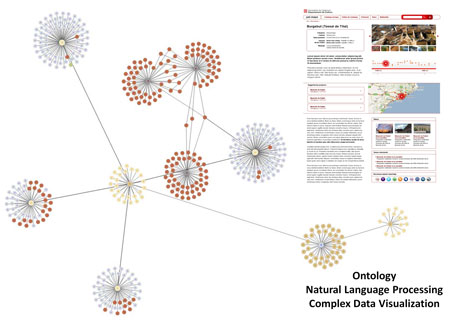by Mercè López, Oriol Almirall and Sergi Fernández
Pat.mapa is an ambitious project that presents the Catalan cultural heritage on the Internet in an integrated and innovative format. The project addresses the semantic web challenge of aggregating cross-domain cultural heritage content into a semantically rich intelligent system. Pat.mapa is an interdisciplinary project that for the first time in the Catalan area, implements the principles of linked data, ontologies and complex data visualization on cultural heritage content.
The mission of Pat.mapa is to present the Catalan cultural heritage content in a different way. Heritage is not an isolated area and only related to the past. Cultural heritage is alive, connected with the real world, the science, the gastronomy, the companies, the people. We can help to bring cultural heritage alive with the implementation of technologies like the Semantic Web. Through the ontological approach, we can see what links exist between the Monastery of Sant Benet de Bages with Ferran Adrià of El Bulli restaurant, or between the Roman Church of Sant Climent de Taüll and the modernist architect Lluís Domènech i Montaner.
Key concepts on which the project is built:
- Representation and vision: Pat.mapa will represent a set of cultural values and assets and offer their differing views and interpretations.
- Evolution and creativity: The project aims to show the evolution of the Catalan cultural heritage in order to promote knowledge generation and innovation as an economic engine and source of cultural wealth.
- Innovation and participation: This project represents innovation in data capture and content presentation. It makes extensive use of digital tools and collaboration in order to develop a Catalan digital culture.
- Quality and proximity. Pat.mapa will become a reference point for the dissemination of cultural heritage and local civil society.
At a technical level, the project represents a major challenge both in the structuring and standardizing of data assets such as technology development (enrichment of ontologies tool and visualization of complex data).
The process of structuring data is based on an intensive mapping between different databases and metadata management (thesauri, controlled vocabularies, etc.). The main innovation and challenge in this work process is the application of the principles of the semantic web. We are working on the implementation of an ontology based on the standard CIDOC Conceptual Reference Model (CRM), that provides definitions and a formal structure for describing the implicit and explicit concepts and relationships used in cultural heritage documentation (official standard ISO 21127:2006).
At the same time, given that much of the relevant information about the history of cultural heritage artefacts (monuments, archaeological sites etc) is in free text fields on the databases, a new tool for natural language processing has been developed. Thus, we can treat complex and abundant sources of text, identify characters and events and incorporate them semi-automatically into the existing ontological structure.
Furthermore, we face the challenge of making visible the entire network of relationships that gives us the ontology. For this reason, the i2cat Foundation is developing a visualization tool that allows complex data visualization of any ontology.. Technically, this means working with converter triple-labelled graphs, a graph viewer and a system of widgets customized according to the ontology. The navigation tool for cultural heritage data is a viewer based on standard HTML5 using processing.js javascript libraries, jQuery and a physics engine developed by Jeff Traer. The viewer reads data from knowledge bases classified on ontologies and shows their relationship graphs. Thanks to the ontology visualization tool, we can provide an interface that allows the user to browse the map of ontologies on cultural heritage. With the presentation of content through this tool, we contribute to the dissemination of knowledge about Catalan cultural heritage.

Figure 1: Pat.mapa overview.
Pat.mapa is a long term project. The starting point is the cultural heritage information but it will continue growing. We are aggregating content from databases on architecture, archaeology and museums, and this will be extended to other areas of knowledge, culture and society (performing arts, and tourism for instance). Pat.mapa is the first step in the Catalan government’s strategy on Linked Data for cultural content. In the near future, we will also face the web 2.0 challenge and explore the possibilities of memory organizations and citizen’s contributions.
Pat.mapa is a project led by the Directorate General for the Cultural Heritage (Department of Culture, Government of Catalonia), developed jointly with the i2cat Foundation and ISOCO Company. The project began in 2008 and is currently in beta. The public presentation is scheduled for November 2011.
Link:
http://patmapa.gencat.cat (beta version):
Please contact:
Mercè López
i2cat Foundation, Spain
Tel: +34 93.551.06.81
E-mail:










